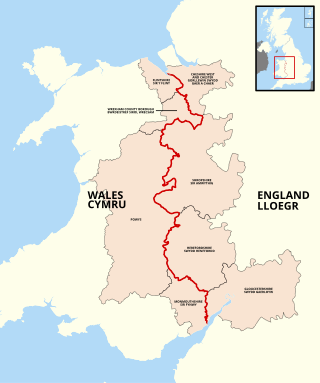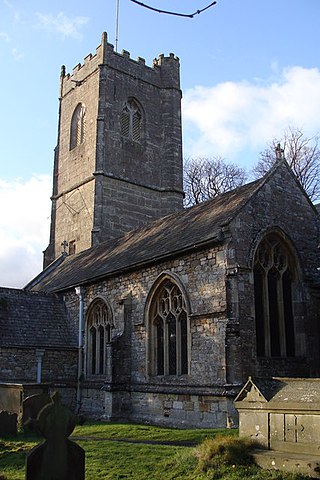
Until 1974, Radnorshire was an administrative county in mid Wales, later classed as one of the thirteen historic counties of Wales. It covered a sparsely populated area, and was bounded to the north by Montgomeryshire and Shropshire, to the east by Herefordshire, to the south by Brecknockshire and to the west by Cardiganshire.

Kington is a market town, electoral ward and civil parish in Herefordshire, England. The ward had a population of 3,240, while the 2011 Census registered a population of 2,626.

Presteigne is a town and community in Radnorshire, Powys, Wales on the south bank of the River Lugg. Formerly the county town of the historic county of Radnorshire, the town has, in common with several other towns close to the Wales-England border, assumed the motto, "Gateway to Wales". The border wraps around three sides of the town. Nearby towns are Kington, Herefordshire to the south and Knighton to the north, and surrounding villages include Norton and Stapleton. The town falls within the Diocese of Hereford. The community has a population of 2,710; the built-up area had a population of 2,056.

Llanymynech is a village and former civil parish straddling the border between Montgomeryshire/Powys, Wales, and Shropshire, England, about 9 miles (14 km) north of the Welsh town of Welshpool. The name is Welsh for "Church of the Monks". The village is on the banks of the River Vyrnwy, and the Montgomery Canal passes through it.

Churchstoke or Church Stoke is a village, community and electoral ward in Montgomeryshire, Powys, Wales. Located in the southeast of the Vale of Montgomery, it is overlooked by Todleth Hill, Roundton Hill and Corndon Hill. The rivers Caebitra and Camlad have their confluence just outside the village. The nearest town is Montgomery. In the 2011 census the village had a population of 708.
Pilleth is a small village south of Knighton in Powys, Wales in the traditional county of Radnorshire. It is the site of the ancient church and holy well of St. Mary’s which stands on Bryn Glas Hill overlooking the River Lugg, as it makes its way to Presteigne.

St Mary's Priory Church, Deerhurst, is the Church of England parish church of Deerhurst, Gloucestershire, England. Much of the church is Anglo-Saxon. It was built in the 8th century, when Deerhurst was part of the Anglo-Saxon kingdom of Mercia. It is contemporary with the Carolingian Renaissance on mainland Europe, which may have influenced it.

St Peter's Church is the parish church of Prestbury, Cheshire, England. It is probably the fourth church on the site. The third, the Norman Chapel, stands in the churchyard. The church is recorded in the National Heritage List for England as a designated Grade I listed building. The Norman Chapel, the lychgate and west wall, the Hearse House, and the sundial in the churchyard are listed at Grade II. It is a Church of England parish church in the diocese of Chester, the archdeaconry of Macclesfield, and the deanery of Macclesfield.

The England–Wales border, sometimes referred to as the Wales–England border or the Anglo-Welsh border, runs for 160 miles (260 km) from the Dee estuary, in the north, to the Severn estuary in the south, separating England and Wales.
Representing 43.6% of the Welsh population in 2021, Christianity is the largest religion in Wales. Wales has a strong tradition of nonconformism, particularly Methodism. From 1534 until 1920 the established church was the Church of England, but this was disestablished in Wales in 1920, becoming the still Anglican but self-governing Church in Wales.

St Michael's Church is in Church Lane, Aughton, Lancashire, England. It is an active Anglican parish church in the deanery of Ormskirk, the archdeaconry of Wigan & West Lancashire, and the diocese of Liverpool. Its benefice is united with that of Holy Trinity, Bickerstaffe. The church is recorded in the National Heritage List for England as a designated Grade I listed building.

St Lawrence's Church is in the village of Morland, Cumbria, England. It is an active Anglican parish church in the deanery of Appleby, the archdeaconry of Carlisle, and the diocese of Carlisle. The parish of Morland includes the historic parish of Thrimby, with its church of St Mary, Little Strickland. The benefice of Morland is united, under the name North Westmorland, with the parishes of Askham and Lowther, Bampton, Bolton, Cliburn, Clifton and Brougham, Crosby Ravensworth, Shap and Great Strickland. The church is recorded in the National Heritage List for England as a designated Grade I listed building. It has the only Anglo-Saxon tower in Cumbria.

Trelystan is a remote parish and township on the border of the historic county of Montgomeryshire with Shropshire. Trelystan now forms part of the community of Forden, Leighton and Trelystan in Powys. Trelystan was a chapel of ease within the parish of Worthen and it also served the township of Leighton. In some old sources the parish is also referred to as Wolston Mynd.

Hyssington is a parish in the South-Eastern corner of the historic county of Montgomeryshire in Wales and borders the county of Shropshire in England. It is now within the area of the Church Stoke community council in Powys. It is dominated by Corndon Hill. The church which is in the Diocese of Hereford lies just the north of a small village and is sited just to the west of a medieval Motte-and-bailey castle. This area was also the source of late Neolithic and Early Bronze Age battle-axes and axe-hammers, made from picrite that were widely traded around 2000 BC.

St Tewdric's Church is a Church in Wales parish church in Mathern, Monmouthshire, Wales. It is purportedly built over the resting place of Saint Tewdrig for whom it is named. A church has been located on the site since the 6th century. It was reconstructed by the Normans in the Early English style, and later was renovated by the Victorians. It is a Grade I listed building.

St Stephen's Church is a Church of England parish church in Old Radnor, Powys, Wales. It was constructed in the 15th century in perpendicular gothic style on the site of a 6th-century church. It is a grade I listed building.

St Nicholas's Church, formerly called St Mary's Church until 1881, is a Church of England parish church in Church Stoke, Powys, Wales. The church's current building is largely the result of 19th-century reconstruction, but it retains its 13th-century tower with a later timber belfry. From the period prior to the 19th century, only a font, a stoup and a chest have survived up to three phases of restoration and reconstruction. The main body of the church with its large high pitched roof dates to the second half of the 19th century. It is a Grade II listed building.

Holy Trinity Church is a Church of England parish church in Sarn, Powys, Wales. It was constructed in 1860 and is one of a small number of churches in Wales where the parishioners voted in 1915 to remain with the Church of England rather than join the Church in Wales.

The Church of England border polls 1915–1916 were a series of referendums held in January and February 1915, for residents of living in nineteen Church of England ecclesiastical parishes, the boundaries of which crossed the England–Wales border. They were carried out to determine if the parish residents wished their parish to remain part of the Church of England or to become part of the Church in Wales when the Welsh Church Act 1914 took effect.. The polls eventually resulted in all but one of the border parishes voting to remain with the Church of England.

St Silin's Church is a Church in Wales parish church in Llansilin, Powys, Wales. The present building, which has parts dating back to the 13th century, is a Grade I listed building. It stands on a site that has been used by Christian communities since the Dark Ages. The church is dedicated to Saint Silin, now better known as Saint Sulien, the 6th-century founder-abbot of a monastery at Luxulyan in Cornwall.

















